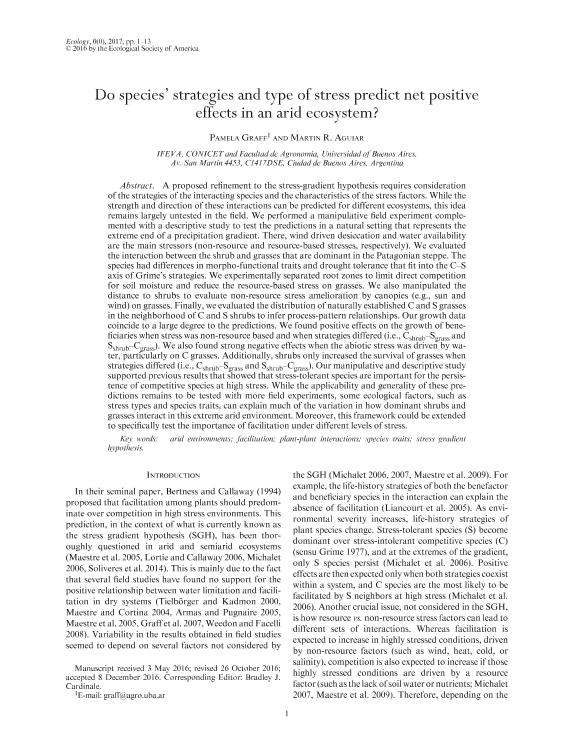Mostrar el registro sencillo del ítem
dc.contributor.author
Graff, Barbara Pamela

dc.contributor.author
Aguiar, Martin Roberto

dc.date.available
2018-06-21T20:46:30Z
dc.date.issued
2017-03
dc.identifier.citation
Graff, Barbara Pamela; Aguiar, Martin Roberto; Do species' strategies and type of stress predict net positive effects in an arid ecosystem?; Ecological Society of America; Ecology; 98; 3; 3-2017; 794-806
dc.identifier.issn
0012-9658
dc.identifier.uri
http://hdl.handle.net/11336/49601
dc.description.abstract
A proposed refinement to the stress-gradient hypothesis requires consideration of the strategies of the interacting species and the characteristics of the stress factors. While the strength and direction of these interactions can be predicted for different ecosystems, this idea remains largely untested in the field. We performed a manipulative field experiment complemented with a descriptive study to test the predictions in a natural setting that represents the extreme end of a precipitation gradient. There, wind driven desiccation and water availability are the main stressors (non-resource and resource-based stresses, respectively). We evaluated the interaction between the shrub and grasses that are dominant in the Patagonian steppe. The species had differences in morpho-functional traits and drought tolerance that fit into the C-S axis of Grime's strategies. We experimentally separated root zones to limit direct competition for soil moisture and reduce the resource-based stress on grasses. We also manipulated the distance to shrubs to evaluate non-resource stress amelioration by canopies (e.g., sun and wind) on grasses. Finally, we evaluated the distribution of naturally established C and S grasses in the neighborhood of C and S shrubs to infer process-pattern relationships. Our growth data coincide to a large degree to the predictions. We found positive effects on the growth of beneficiaries when stress was non-resource based and when strategies differed (i.e., Cshrub-Sgrass and Sshrub-Cgrass). We also found strong negative effects when the abiotic stress was driven by water, particularly on C grasses. Additionally, shrubs only increased the survival of grasses when strategies differed (i.e., Cshrub-Sgrass and Sshrub-Cgrass). Our manipulative and descriptive study supported previous results that showed that stress-tolerant species are important for the persistence of competitive species at high stress. While the applicability and generality of these predictions remains to be tested with more field experiments, some ecological factors, such as stress types and species traits, can explain much of the variation in how dominant shrubs and grasses interact in this extreme arid environment. Moreover, this framework could be extended to specifically test the importance of facilitation under different levels of stress.
dc.format
application/pdf
dc.language.iso
eng
dc.publisher
Ecological Society of America

dc.rights
info:eu-repo/semantics/openAccess
dc.rights.uri
https://creativecommons.org/licenses/by-nc-sa/2.5/ar/
dc.subject
ARID ENVIRONMENTS
dc.subject
FACILITATION
dc.subject
PLANT-PLANT INTERACTIONS
dc.subject
SPECIES TRAITS
dc.subject
STRESS GRADIENT HYPOTHESIS
dc.subject.classification
Otras Ciencias Biológicas

dc.subject.classification
Ciencias Biológicas

dc.subject.classification
CIENCIAS NATURALES Y EXACTAS

dc.title
Do species' strategies and type of stress predict net positive effects in an arid ecosystem?
dc.type
info:eu-repo/semantics/article
dc.type
info:ar-repo/semantics/artículo
dc.type
info:eu-repo/semantics/publishedVersion
dc.date.updated
2018-06-19T15:59:52Z
dc.identifier.eissn
1939-9170
dc.journal.volume
98
dc.journal.number
3
dc.journal.pagination
794-806
dc.journal.pais
Estados Unidos

dc.description.fil
Fil: Graff, Barbara Pamela. Consejo Nacional de Investigaciones Científicas y Técnicas. Oficina de Coordinación Administrativa Parque Centenario. Instituto de Investigaciones Fisiológicas y Ecológicas Vinculadas a la Agricultura. Universidad de Buenos Aires. Facultad de Agronomía. Instituto de Investigaciones Fisiológicas y Ecológicas Vinculadas a la Agricultura; Argentina
dc.description.fil
Fil: Aguiar, Martin Roberto. Consejo Nacional de Investigaciones Científicas y Técnicas. Oficina de Coordinación Administrativa Parque Centenario. Instituto de Investigaciones Fisiológicas y Ecológicas Vinculadas a la Agricultura. Universidad de Buenos Aires. Facultad de Agronomía. Instituto de Investigaciones Fisiológicas y Ecológicas Vinculadas a la Agricultura; Argentina
dc.journal.title
Ecology

dc.relation.alternativeid
info:eu-repo/semantics/altIdentifier/doi/https://doi.org/10.1002/ecy.1703
dc.relation.alternativeid
info:eu-repo/semantics/altIdentifier/url/https://esajournals.onlinelibrary.wiley.com/doi/abs/10.1002/ecy.1703
Archivos asociados
